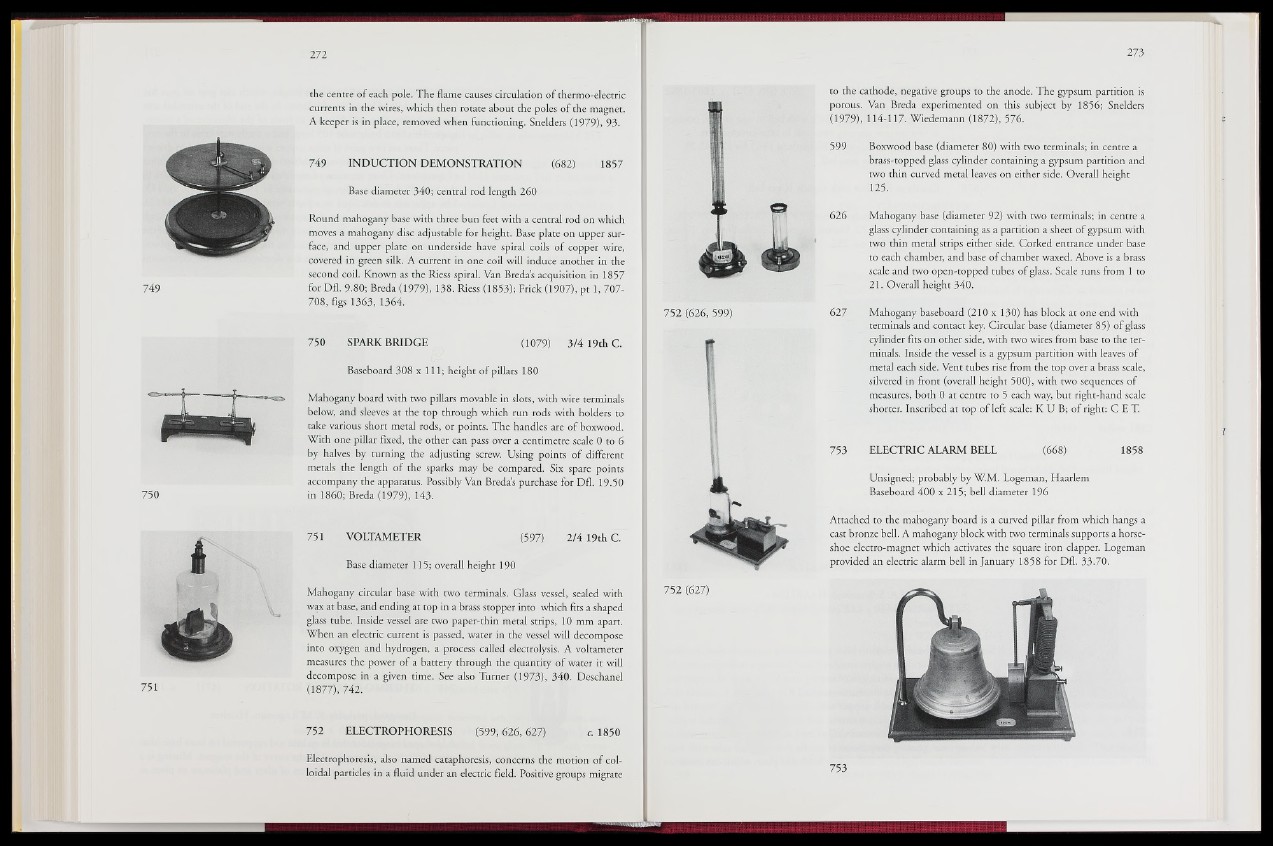
the centre of each pole. The flame causes circulation of thermo-electric
currents in the wires, which then rotate about the poles of the magnet.
A keeper is in place, removed when functioning. Snelders (1979), 93.
749 INDUCTION DEMONSTRATION (682) 1857
Base diameter 340; central rod length 260
Round mahogany base with three bun feet with a central rod on which
moves a mahogany disc adjustable for height. Base plate on upper surface,
and upper plate on underside have spiral coils of copper wire,
covered in green silk. A current in one coil will induce another in the
second coil. Known as the Riess spiral. Van Breda’s acquisition in 1857
for Dfl. 9.80; Breda (1979), 138. Riess (1853); Frick (1907), pt 1, 707-
708, figs 1363, 1364.
750 SPARK BRIDGE (1079) 3/4 19th C.
Baseboard 308x 111; height of pillars 180
Mahogany board with two pillars movable in slots, with wire terminals
below, and sleeves at the top through which run rods with holders to
take various short metal rods, or points. The handles are of boxwood.
With one pillar fixed, the other can pass over a centimetre scale 0 to 6
by halves by turning the adjusting screw. Using points of different
metals the length of the sparks may be compared. Six spare points
accompany the apparatus. Possibly Van Breda’s purchase for Dfl. 19.50
in 1860; Breda (1979)^8.43.
751 VOLTAMETER (597), 2/4 19th C.
Base diameter 115; overall height 190
Mahogany circular base with two terminals. Glass vessel, sealed with
wax at base, and ending at top in a brass stopper into- which fits a shaped
glass tube. Inside vessel are two paper-thin metal strips, 10 mm apart.
When an electric current is passed, water in the vessel will decompose
into oxygen and hydrogen, a process called electrolysis. A voltameter
measures the power of a battery through the quantity of water it will
decompose in a given time. See also Turner (1973), 340. Deschanel
(1877), 742.
752 ELECTROPHORESIS « 5 9 9 , 6 2 6 ,6 2 § ¡g | c. 1850
Electrophoresis, also named cataphoresis, concerns the motion of colloidal
particles in’a fluid under an electric field. Positive groups migrate
752 (626, 599)
to the cathode, negative groups to the anode. The gypsum partition is
porous. Van Breda experimented on this subject by 1856; Snelders
(1979), 114-117. Wiedemann (1872), 576.
599 Boxwood base (diameter 80) with two terminals; in centre a
brass-topped glass cylinder containing "a gypsum partition and
two thin curved metal leaves on either side. Overall height
125.
626 Mahogany base (diameter 92) wick! two terminals; in centre a
glass cylinder containing as a partition a sheet of gypsum with
two thin metal strips either side. Corked entrance under base
to each chamber, and base of chamber waxed. Above is a brass
scale and two open-topped tubes of glass. Scale runs from 1 to
2MOverall height 340.
627 Mahogany baseboard (210 x 130) has block at one end with
terminals and contact key. Circular base (diameter 85) of glass
cylinder fits on other side, with two wires from base to the terminals.
Inside the vessel is a gypsum partition with leaves of
metal each side. Vent tubes rise from the top over a brass scale,
silvered in front (overall height 500), with two sequences of
measures, both 0 at centre to 5 each way, but right-hand scale
shorter. Inscribed at top of left scale: K U B; of right: C E T.
753 ELECTRIC ALARM BELL (668) 1858
Unsigned; probably by W.M. Logeman, Haarlem
Baseboard 400 x 215; bell diameter 196
Artac-thed to the mahogany board is a curved pillar from which hangs a
cast bronze bell. A mahogany block with two terminals supports a horseshoe
electro-magnet which activates the square iron clapper. Logeman
provided an electric alarm bell in January 1858 for Dfl. 33.70.
752 (627)